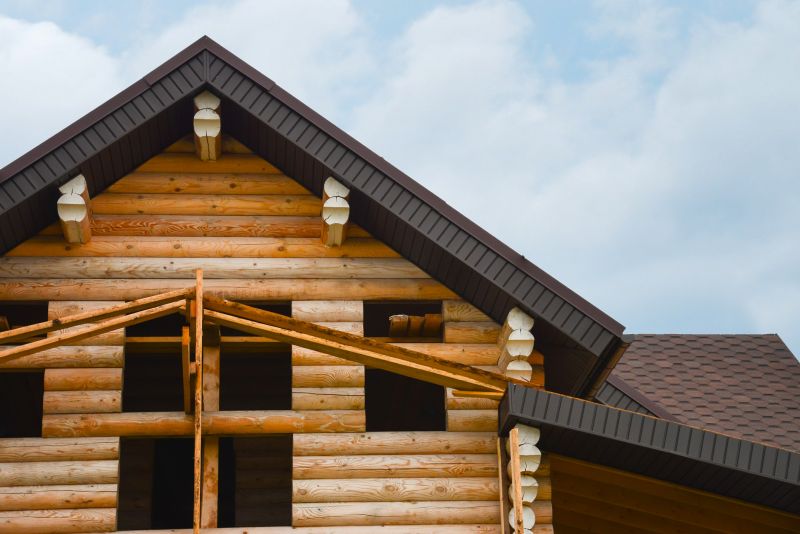Top-Rated Tools And Materials For Log Siding Projects
Browse the most trusted products designed to streamline your log siding installation and ensure lasting quality.
 Log siding installation involves a variety of products designed to ensure a secure, durable, and aesthetically pleasing finish. Selecting the right materials and tools is essential for achieving professional results, whether you're constructing a new log siding or maintaining an existing structure. From fastening hardware to sealants, each component plays a vital role in the longevity and appearance of the siding. Understanding the different types of products available can help homeowners and contractors make informed decisions tailored to their specific project needs.
Log siding installation involves a variety of products designed to ensure a secure, durable, and aesthetically pleasing finish. Selecting the right materials and tools is essential for achieving professional results, whether you're constructing a new log siding or maintaining an existing structure. From fastening hardware to sealants, each component plays a vital role in the longevity and appearance of the siding. Understanding the different types of products available can help homeowners and contractors make informed decisions tailored to their specific project needs.
Top Overall Option
Log Siding Fastening System
A comprehensive fastening system designed specifically for log siding installations, offering a combination of nails, screws, and anchors that provide secure attachment and minimize wood damage. This type of system often includes corrosion-resistant hardware suitable for outdoor use, ensuring long-lasting performance. Its versatility makes it a popular choice for both DIY enthusiasts and professional contractors aiming for reliable results.
Types of Products For Log Siding Installations
Log Siding Nails
Specialized nails designed to securely attach log siding panels to the underlying structure, often featuring corrosion resistance and specific head designs for easy driving.
Log Siding Screws
Heavy-duty screws that provide strong holding power, suitable for thicker logs and areas requiring extra stability.
Moisture Barriers
Vapor barriers or house wraps that help prevent moisture infiltration behind the siding, reducing the risk of rot and mold.
Sealants and Caulks
Flexible, weather-resistant sealants used to fill gaps and joints, enhancing insulation and preventing water penetration.
Wood Preservatives
Treatments applied to logs before or after installation to protect against decay, pests, and fungal growth.
Log Siding Clips
Metal or plastic clips that facilitate the installation process by holding logs in place temporarily or permanently.
Finish Stains and Sealers
Products used to enhance the appearance and provide additional protection to log siding surfaces.
Corner and Edge Trim
Trim pieces that provide a finished look at corners and edges, also helping to seal and protect vulnerable areas.
Insulation Boards
Insulation materials that can be installed behind log siding to improve thermal efficiency.
Fastening Tools
Power tools like nail guns and screwdrivers designed for efficient installation of siding components.
Drainage Mats
Materials installed behind siding to facilitate water drainage and reduce moisture buildup.
Expansion Joints
Components that accommodate wood expansion and contraction, preventing cracking or warping.
Backing Rods
Foam or rubber rods used with sealants to fill larger gaps and joints.
Weatherproofing Paints
Coatings that add an extra layer of weather resistance and aesthetic appeal.
Log Siding Adhesives
Specialized adhesives for securing logs or panels where mechanical fasteners are not suitable.
Popular Choices
Widely used for their ease of installation and compatibility with various log types.
Commonly chosen for their flexibility and durability in sealing joints and gaps.
Popular for protecting structures from water infiltration behind log siding.
Favored for their strength and holding power in thicker log applications.
Often selected for enhancing the appearance and providing surface protection.
Commonly used to give a polished look at corners and edges.
Popular for managing wood movement and preventing structural issues.
Chosen for improving energy efficiency behind log siding.
Preferred for speeding up the installation process, especially on large projects.
Frequently used to enhance moisture management behind siding.
Popular tools that ensure precise application of sealants and caulks.
Commonly used with sealants to fill large gaps effectively.
Selected for their protective qualities and aesthetic options.
Often chosen for their ease of installation and secure hold.
Proper installation requires attention to detail and the use of high-quality materials that can withstand the stresses of weather and time. Structural supports and moisture barriers are often necessary to prevent issues such as warping or rot. Additionally, finishing products like stains and sealants help preserve the wood's natural beauty while providing protection against the elements. The right combination of products can also facilitate easier installation and maintenance, saving time and effort in the long run.
When selecting products for log siding installation, it is important to consider compatibility with the type of wood used, ease of application, and the specific environmental conditions of the installation site. Some products are designed for DIY projects, offering straightforward application methods, while others may be better suited for professional use. Careful planning and choosing appropriate products can lead to a more efficient process and a more durable finished product, ensuring your log siding remains attractive and functional for years to come.
Key Buying Considerations
- Compatibility with the type and thickness of log siding being installed.
- Corrosion resistance of fasteners and hardware for outdoor durability.
- Ease of application and whether the product suits DIY or professional use.
- Weather resistance properties to withstand local climate conditions.
- Compatibility with existing or planned insulation and moisture barriers.
- Long-term durability and resistance to pests, rot, and fungal growth.
- Flexibility of sealants and caulks to accommodate wood expansion and contraction.
- Product certifications or standards indicating quality and safety.
- Ease of maintenance and reapplication when necessary.
- Availability of tools and accessories that facilitate installation.
- Cost-effectiveness based on longevity and performance.
- Aesthetic options, especially for finishes and trims.
- Environmental conditions like humidity, temperature fluctuations, and precipitation.
- Type of installation (DIY vs professional) and required skill level.
- Compatibility with other building materials used in the project.
